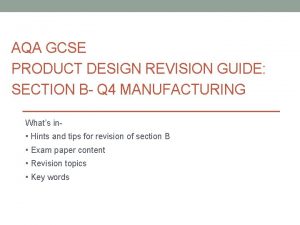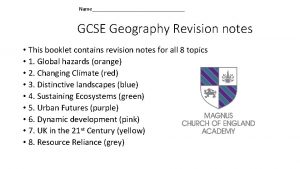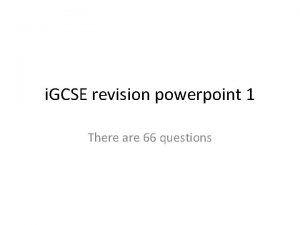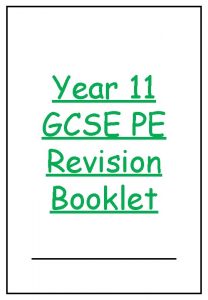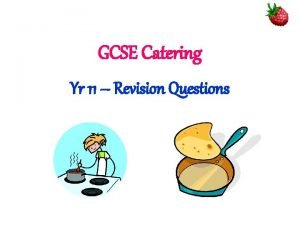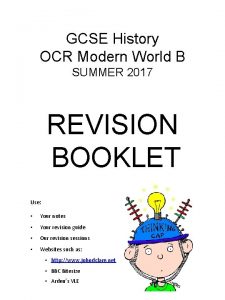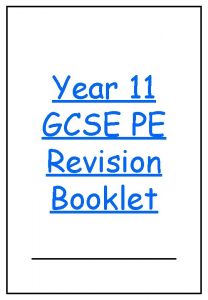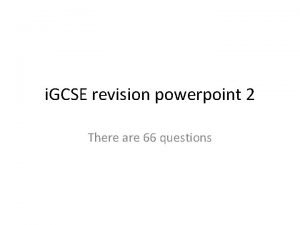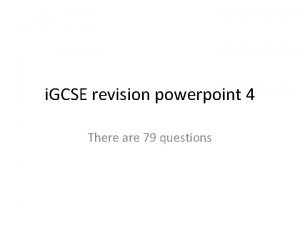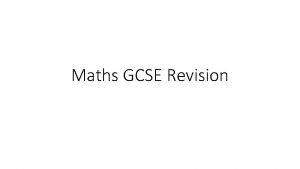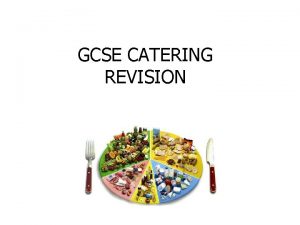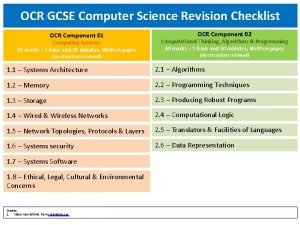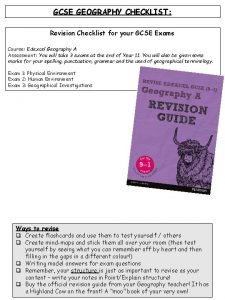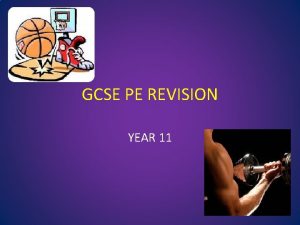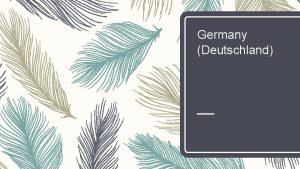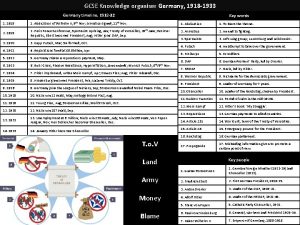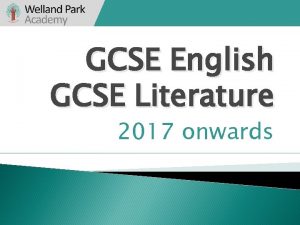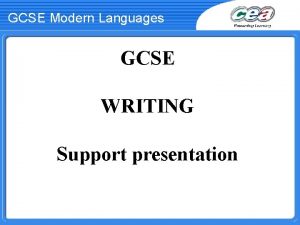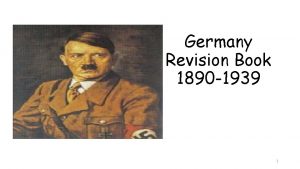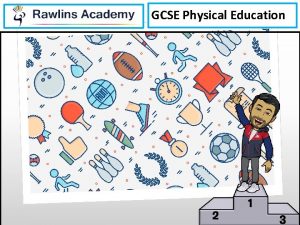GCSE Revision Tests Welcome to the third Germany




























- Slides: 28

GCSE Revision Tests Welcome to the third Germany skills test. To achieve your potential in your GCSE’s, you need to master the skills needed to answer thoroughly both the source and essay questions. The skills you practise through this presentation will equip you with these skills. Try the tasks as you go through the Power. Point“think before you click”.

GCSE Revision Tests BEFORE YOU START- REMEMBER! This is a worked example of a source question. It picks out every part and covers all those parts in its answer. It is written by members of staff, not GCSE students- so don’t panic that you have to do all these things to pass your GCSE! This presentation is training you on the skills you needyou would only have to pick out 2 -3 points from the source to achieve a high mark. Check the mark scheme on a later slide to remind you of what you need to do to achieve your target grade.

GCSE Revision Tests This Skills Test will work through two sources from the “Medicine” section of the paper, and focus on a question that asks you to consider both sources. Click on to see the sources, and the question that follows!

GCSE Revision Tests SOURCE A After awakening he should rub his whole body with some oil. Every day he should wash his face and eyes with his hands using pure water. He should rub his teeth inside and outside with the fingers using some peppermint powder and cleaning the teeth of food. A young or middle-aged man should take a walk just before sunrise. Long walks before meals clear out the body, prepare it for receiving food and give it more power for digesting. Written by a Greek doctor who was a follower of Hippocrates, around 390 BC.

GCSE Revision Tests SOURCE B: A painting from the time of the Black Death in the mid-fourteenth century.

GCSE Revision Tests THE QUESTION: • Study Sources A and B. How similar are the ideas about disease in these two sources? Use the sources and your knowledge to explain your answer. WHAT IS THE WAY TO “GET AN A”? CLICK TO REVEAL THE ANSWER!

GCSE Revision Tests THE QUESTION: • Study Sources A and B. How similar are the ideas about disease in these two sources? Use the sources and your knowledge to explain your answer. AQUSOK Answer Question Use Source Own Knowledge

GCSE Revision Tests THE QUESTION: • Study Sources A and B. How similar are the ideas about disease in these two sources? Use the sources and your knowledge to explain your answer. TASK ONE: What are the key words of the question?

GCSE Revision Tests THE QUESTION: • Study Sources A and B. How similar are the ideas about disease in these two sources? Use the sources and your knowledge to explain your answer. KEY WORDS • • How similar- to what extent are they? Ideas about disease- the topic you look at Two sources- talk about both! Use. . . sources. . . your knowledge- telling you how to answer the question- AQUSOK!

GCSE Revision Tests THE QUESTION: • Study Sources A and B. How similar are the ideas about disease in these two sources? Use the sources and your knowledge to explain your answer. TASK TWO: USE THE SOURCE! What can you pick out from the source? What period of medicine is this from? What does it tell us regarding this civilisations’ ideas about disease? (Click on to study Source A)

GCSE Revision Tests SOURCE A After awakening he should rub his whole body with some oil. Every day he should wash his face and eyes with his hands using pure water. He should rub his teeth inside and outside with the fingers using some peppermint powder and cleaning the teeth of food. A young or middle-aged man should take a walk just before sunrise. Long walks before meals clear out the body, prepare it for receiving food and give it more power for digesting. Written by a Greek doctor who was a follower of Hippocrates, around 390 BC. Click on to reveal the answers!

GCSE Revision Tests SOURCE A After awakening he should rub his whole body with some oil. Every day he should wash his face and eyes with his hands using pure water. He should rub his teeth inside and outside with the fingers using some peppermint powder and cleaning the teeth of food. A young or middle-aged man should take a walk just before sunrise. Long walks before meals clear out the body, prepare it for receiving food and give it more power for digesting. Written by a Greek doctor who was a follower of Hippocrates, around 390 BC. Click on to the next slide to find out why it’s useful!

GCSE Revision Tests. . . rub his whole body with some oil. Every day he should wash his face and eyes with his hands using pure water. This shows us that the doctor recommended washing your body, face and eyes! . . . rub his teeth inside and outside with the fingers using some peppermint powder and cleaning the teeth of food. This shows us that the doctor also recommends keeping your teeth clean! . . . take a walk. . . Long walks before meals clear out the body, prepare it for receiving food and give it more power for digesting. Written by a Greek doctor who was a follower of Hippocrates, around 390 BC. This suggests the doctor recommends exercise, linking it to a healthy digestive system! This shows us that it’s from the Greek civilisation, from a doctor who followed Hippocrates’ methods! NOW LET’S MOVE ON TO SOURCE B!

GCSE Revision Tests Click on to reveal the answer! SOURCE B: A painting from the time of the Black Death in the mid-fourteenth century.

GCSE Revision Tests Click again to see what these tell us SOURCE B: A painting from the time of the Black Death in the mid-fourteenth century.

GCSE Revision Tests E S E HNO A whip T O E D S R T A T E AS A A S E E H D E I E R G W D ? R I L E G T ? A A H U ? G U T S R E Y N B I N S U E D E A T H R H E A T Mid A Laying hands T ! S I N , L Fourteenth EG E D L K on people A L R N I R Century=R E UT A (praying) H U N O A T ATO Middle Ages H B A K N E C I V ER Black Death! L A P C B: A painting from the time of H SOURCE Carrying a cross SUthe Black Death in the mid-fourteenth century.

GCSE Revision Tests THE QUESTION: • Study Sources A and B. How similar are the ideas about disease in these two sources? Use the sources and your knowledge to explain your answer. TASK THREE: WHAT DO YOU KNOW? What do you know about: a) Greek Medicine? b) Medieval Medicine? c) The Black Death? THINK BEFORE YOU CLICK ON!

GCSE Revision Tests TASK THREE: What do I know that can add to the quality of my answer? Greek Medicine: Time of Hippocrates, when focus was on careful observation and recording of patient’s symptoms. Hippocrates rejected supernatural ideas, and searched for natural causes/cures. Despite not understanding why, they had made a link between dirt and disease on an individual level. Medieval Medicine: Time after Roman Medicine, when emphasis was on tradition, and the Church played a vital role. Lack of understanding led to supernatural explanations regarding the causes and cures of disease. The Black Death: A plague which killed 40% of Britain’s population. The case of this condition was unknown, as was any real cure, leading to ideas such as that it was a punishment from God.

GCSE Revision Tests THE QUESTION: • Study Sources A and B. How similar are the ideas about disease in these two sources? Use the sources and your knowledge to explain your answer. TASK FOUR: Remind yourself of the “Criteria for Success!” Take a look at this generic mark scheme- what must you do in order to reach your target grade? In the exam, this won’t be available of course, but you can still remember the key to success- AQUSOK!

GCSE Revision Tests THE QUESTION: • Study Sources A and B. How similar are the ideas about disease in these two sources? Use the sources and your knowledge to explain your answer. REMEMBERE: Make a general assertion about Greek ideas or Medieval ideas regarding disease. D: Highlight from the source either Greek or Medieval ideas regarding disease C: Use source OR own knowledge to suggest how similar the ideas are. B: Uses source AND own knowledge to answer question; EXPLAINS how similar these sources are. A: Source and own knowledge INTEGRATED together to answer the question; DETAILED EXPLANATION of the similarities/differences of these two sources. A*: All aspects of ‘A’ grade included, with clear explanation of why these two sources are similar/different.

GCSE Revision Tests THE QUESTION: • Study Sources A and B. How similar are the ideas about disease in these two sources? Use the sources and your knowledge to explain your answer. Why not have a go then? On the next slide you’ll see the sources & the question. On the slides that follow, you’ll see a model answer that you can compare yours to, and an explanation as to why the model answer is so good!

GCSE Revision Tests SOURCE A After awakening he should rub his whole body with some oil. Every day he should wash his face and eyes with his hands using pure water. He should rub his teeth inside and outside with the fingers using some peppermint powder and cleaning the teeth of food. A young or middle-aged man should take a walk just before sunrise. Long walks before meals clear out the body, prepare it for receiving food and give it more power for digesting. THE QUESTION: • Study Sources A and B. How similar are the ideas about disease in these two sources? Use the sources and your knowledge to explain your answer. Written by a Greek doctor who was a follower of Hippocrates, around 390 BC. SOURCE B: A painting from the time of the Black Death in the mid-fourteenth century.

GCSE Revision Tests MODEL ANSWER Sources A and B shows that the ideas about disease in these two civilisations were very different. Source A is written by a Greek doctor who followed Hippocrates. He recommends that a person should “. . . wash his face and eyes with his hands using pure water” every day. He also recommends rubbing “. . . his teeth inside and outside with the fingers using some peppermint powder”. Hippocrates was the first doctor to focus solely on natural causes and cures of disease, and these treatments suggest that looking after your body, keeping it clean, will help fight off illness and disease. The doctor also recommends exercise to help establish a good digestive system, telling men to “take a walk” to “clear out the body. . . And give it more power for digesting”. In contrast, Source B shows no natural understanding of the cause or cure of disease. Here I can see people whipping each other, being prayed for and holding religious symbols such as the cross. It is from the fourteenth century, the Middle Ages. This was a time where the ideas of observation from the Greeks & Romans had disappeared, and people hung on to tradition. They blindly accepted the Roman doctor Galen’s methods, and the Church played a huge role in society. The painting was from the time of the Black Death, when 40% of the population was killed by a plague. The source suggests that there was no natural understanding of this disease, and that people looked to God to have mercy on them. Source A was written 1700 years before Source B was painted, and yet it shows a massive decline with regards to ideas about disease. Overall, these two sources don’t show similarities regarding ideas about disease, but rather vast differences.

GCSE Revision Tests THE QUESTION: • Study Sources A and B. How similar are the ideas about disease in these two sources? Use the sources and your knowledge to explain your answer. Why is this answer so good? Have a go at AQUSOK-ING it!

GCSE Revision Tests MODEL ANSWER Sources A and B shows that the ideas about disease in these two civilisations were very different. Source A is written by a Greek doctor who followed Hippocrates. He recommends that a person should “. . . wash his face and eyes with his hands using pure water” every day. He also recommends rubbing “. . . his teeth inside and outside with the fingers using some peppermint powder”. Hippocrates was the first doctor to focus solely on natural causes and cures of disease, and these treatments suggest that looking after your body, keeping it clean, will help fight off illness and disease. The doctor also recommends exercise to help establish a good digestive system, telling men to “take a walk” to “clear out the body. . . And give it more power for digesting”. In contrast, Source B shows no natural understanding of the cause or cure of disease. Here I can see people whipping each other, being prayed for and holding religious symbols such as the cross. It is from the fourteenth century, the Middle Ages. This was a time where the ideas of observation from the Greeks & Romans had disappeared, and people hung on to tradition. They blindly accepted the Roman doctor Galen’s methods, and the Church played a huge role in society. The painting was from the time of the Black Death, when 40% of the population was killed by a plague. The source suggests that there was no natural understanding of this disease, and that people looked to God to have mercy on them. Source A was written 1700 years before Source B was painted, and yet it shows a massive decline with regards to ideas about disease. Overall, these two sources don’t show similarities regarding ideas about disease, but rather vast differences.

GCSE Revision Tests MODEL ANSWER- ANSWER QUESTION, USE SOURCE, OWN KNOWLEDGE Sources A and B shows that the ideas about disease in these two civilisations were very different. Source A is written by a Greek doctor who followed Hippocrates. He recommends that a person should “. . . wash his face and eyes with his hands using pure water” every day. He also recommends rubbing “. . . his teeth inside and outside with the fingers using some peppermint powder”. Hippocrates was the first doctor to focus solely on natural causes and cures of disease, and these treatments suggest that looking after your body, keeping it clean, will help fight off illness and disease. The doctor also recommends exercise to help establish a good digestive system, telling men to “take a walk” to “clear out the body. . . And give it more power for digesting”. In contrast, Source B shows no natural understanding of the cause or cure of disease. Here I can see people whipping each other, being prayed for and holding religious symbols such as the cross. It is from the fourteenth century, the Middle Ages. This was a time where the ideas of observation from the Greeks & Romans had disappeared, and people hung on to tradition. They blindly accepted the Roman doctor Galen’s methods, and the Church played a huge role in society. The painting was from the time of the Black Death, when 40% of the population was killed by a plague. The source suggests that there was no natural understanding of this disease, and that people looked to God to have mercy on them. Source A was written 1700 years before Source B was painted, and yet it shows a massive decline with regards to ideas about disease. Overall, these two sources don’t show similarities regarding ideas about disease, but rather vast differences.

GCSE Revision Tests THE QUESTION: • Study Sources A and B. How similar are the ideas about disease in these two sources? Use the sources and your knowledge to explain your answer. WHY GIVE IT FULL MARKS? • It directly answers the question • It quotes from Source A, and highlights key points from Source B • It includes knowledge relevant to both sources • It integrates (combines) talking about the source and including its own knowledge • It keeps its knowledge focused on the question • It makes sure it concludes clearly its’ answer to the question.

GCSE Revision Tests Follow this procedure in answering source questions, and (providing you’re revising!!) you’re guaranteed to succeed! GOOD LUCK!
 Ace different tests iq tests still
Ace different tests iq tests still Passive voice revision
Passive voice revision Product design revision
Product design revision Geography gcse revision notes
Geography gcse revision notes Gcse maths revision ppt
Gcse maths revision ppt Food technology gcse revision
Food technology gcse revision Labelled diagram of the heart gcse
Labelled diagram of the heart gcse Gcse catering revision
Gcse catering revision How useful is this source
How useful is this source Gcse pe revision booklet
Gcse pe revision booklet Revision techniques gcse powerpoint
Revision techniques gcse powerpoint Gcse child development revision powerpoint
Gcse child development revision powerpoint Aqa maths gcse revision guide
Aqa maths gcse revision guide Gcse catering revision
Gcse catering revision Anticipating misuse computer science
Anticipating misuse computer science Gcse geography edexcel b revision checklist
Gcse geography edexcel b revision checklist Gingival third vs cervical third
Gingival third vs cervical third Gj mount classification
Gj mount classification Hope you had a great summer break
Hope you had a great summer break Welcome welcome this is our christmas story
Welcome welcome this is our christmas story Cong thức tính động năng
Cong thức tính động năng Môn thể thao bắt đầu bằng từ chạy
Môn thể thao bắt đầu bằng từ chạy Sự nuôi và dạy con của hươu
Sự nuôi và dạy con của hươu Thế nào là mạng điện lắp đặt kiểu nổi
Thế nào là mạng điện lắp đặt kiểu nổi Hình ảnh bộ gõ cơ thể búng tay
Hình ảnh bộ gõ cơ thể búng tay Dot
Dot Biện pháp chống mỏi cơ
Biện pháp chống mỏi cơ Phản ứng thế ankan
Phản ứng thế ankan Gấu đi như thế nào
Gấu đi như thế nào


